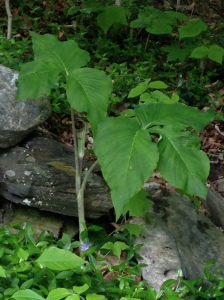
I can’t get enough of these.
I’ve never bought one; they just spring up here and there on the hillside. Sometimes I gently move them to another location if their self-seeded spot might be imperiled by my careless activities later in the season.


I can’t get enough of these.
I’ve never bought one; they just spring up here and there on the hillside. Sometimes I gently move them to another location if their self-seeded spot might be imperiled by my careless activities later in the season.

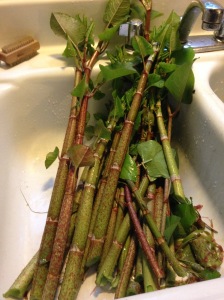
For a couple weeks, I regularly harvest Japanese knotweed shoots while they are small and manageable. They’ve begun to spring up on our side of the brook, which means it’s only a matter of time until every other living thing has been crowded out and all we’ll see is knotweed. I assuage my despair by eating as much of it as I can.
Wash and peel the shoots with a vegetable peeler, blanche them in boiling water, and throw into the food processor, then ladle the soupy result into jars and freeze or use immediately.
My favorite use for knotweed is as a base for green salsa. The flavor is somewhere between tomatillos and lemon, so I leave those two non-local ingredients out and mix the knotweed with homegrown garlic, onions, cilantro, and jalapeños. It’s delicious.
In the winter I thaw a jar of knotweed every couple of weeks to use in recipes. Knotweed is excellent in a white bean-chicken chili and any number of Mexican-ish casseroles or quinoa-avocado-type salads. I’ve also added it to a yummy strawberry-rhubarb compote.
There is evidence that eating knotweed alleviates the symptoms of Lyme disease and possibly prevents it. It’s also loaded with vitamins and anti-oxidants.

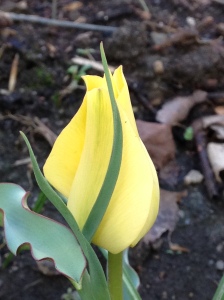
Last fall I planted these deer-resistant yellow tulip bulbs from Agway given to me by a friend.
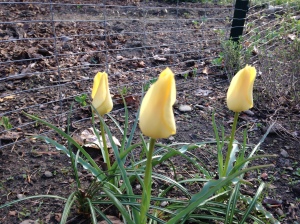
For some reason (possibly the steep bank on one side and the brook on the other), deer avoid my yard, but I’m plagued by squirrels, who eat bulbs like candy. They left these alone.
The flowers looked like Mint Meltaways and kept blooming for weeks. They were particularly beautiful with forget-me-nots. Next year I’ll have more.
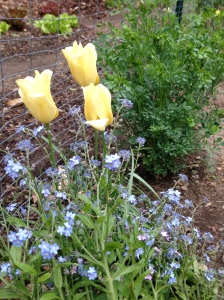
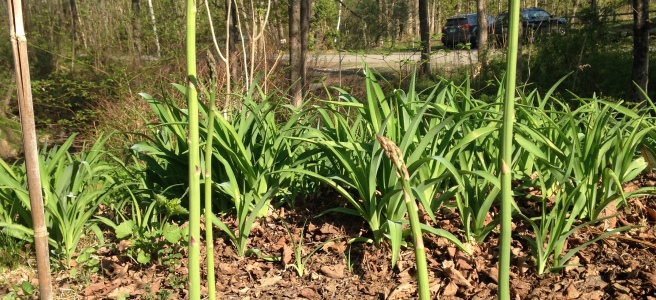
According to the dates on my camera, this was the asparagus on May 1:
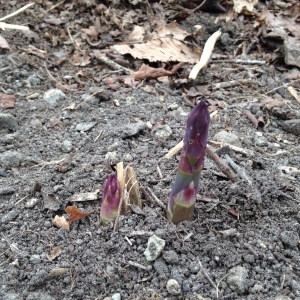
And here it is on May 8:
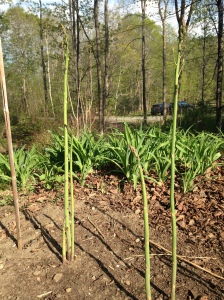
Wow.
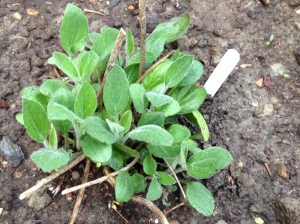
Rudbeckia. I think I got it at the Rockingham Library plant sale. Splendid and vigorous.
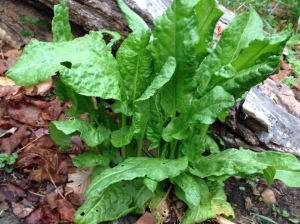
Sorrel. Forgot to harvest in time for sorrel soup (my favorite). Later in the season it got tough and unpleasant.
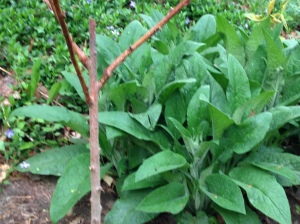
This is the ‘Reliance’ peach tree that was destroyed when a large tree limb fell on it.
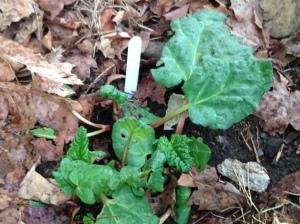
This is the rhubarb that was destroyed when the dog dug it up.
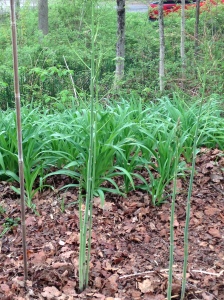
This is the beautiful asparagus that needed nothing all season but an occasional watering. The leaf mulch kept out weeds, and the daylilies kept a polite distance.
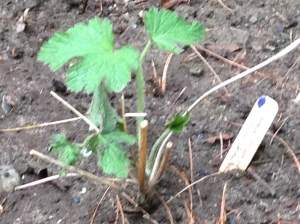
Sure would be helpful if I could read those tags.
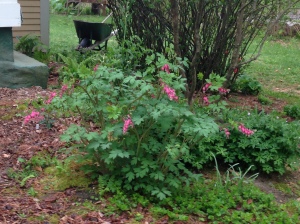
I dug up tons of self-seeded babies from this bleeding heart and transplanted them in a nursery bed. I would love to have swathes of these through the yard. By midsummer they’re gone without a trace.
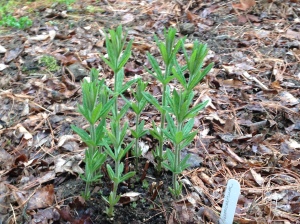
Veronicastrum from Nasami Farm. Can’t wait to see it become a huge, billowing beauty.
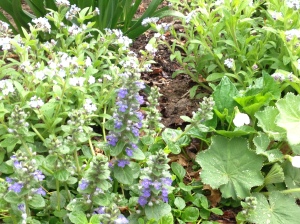
Overexposed photo of ajuga and forget-me-nots blooming like crazy.
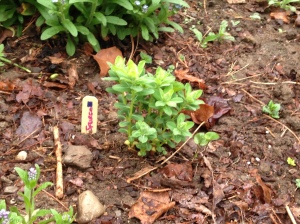
A Euphorbia (spurge) from the library plant sale. Variety unknown. It ended up being very pretty. I’ll have to research whether I can divide it to make more.

Okay, this and the next couple dozen posts are total cheats. That is, the dates are made up. I’m posting these in February 2016 but dating them back in last summer. The dates in the post titles correspond to the dates of the photos.
The whole point of this blog was supposed to be a journal to keep track of daily chores and events in my garden, but during the gardening season I was always too tired at night to update my journal. So now I’m going back to my trusty iPhone, with its handy date-stamps, posting the photos, and writing notes on whatever I can recall about what the photo was supposed to document.
(Maybe this year I’ll do better.)
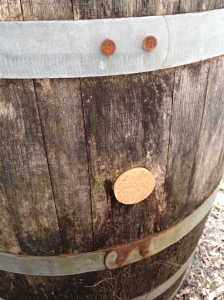
I bought a cork stopper for my rain barrel from Hearts & Crafts online store. For several weeks it leaked so much it was useless, but by summer’s end the cork had swollen to fit, and the rain barrel was nice and tight.
For a second rain barrel, I came up with a good hack to keep breeding mosquitoes out. (I’m sure someone else came up with this before.) I used a plastic garbage can with a lid. With a utility knife, I cut around the rim of the lid, threw away the center piece, and replaced it with a piece of window screen (trimmed to fit with wire cutters).
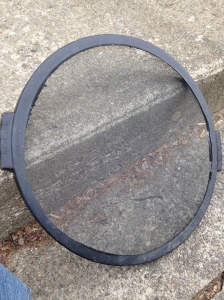
Rain in, mosquitoes out.
The black plastic rain barrel was ugly, but I hid it behind a giant hydrangea and a cimicifuga.
Two special gifts…
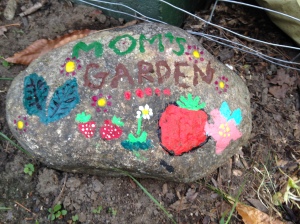
The kids helped me plant these ‘Silver Plumage’ daylilies from Olallie Daylily Farm. These are ‘Size B’ fans. They’re a great deal: they look tiny but spread fast.
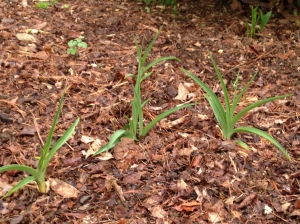
Here’s what their flowers will look like.
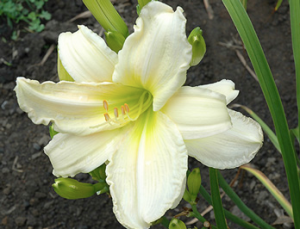
I love the chartreuse throat.
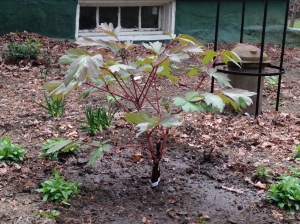
A ‘Yachiyotsubaki’ tree peony (from Walker Farm, Dummerston). In my experience, tree peonies require almost no care, are shockingly beautiful in bloom and handsomely sculptural when not flowering, and get better and better with age.
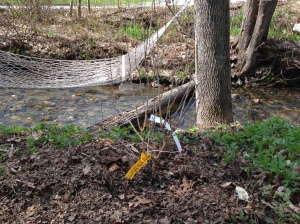
Philadelphus ‘Minnesota Snowflake,’ aka mock orange (from Allen Brothers Nursery in Westminster). I thought I was buying a dwarf plant to go right under the kitchen window where the fragrance would fill the house at night. When I got it home, though, I realized I had a baby that was going to grow to be about ten feet tall, so I found the perfect spot at the top of the brook bank. We’ll be able to smell it from the hammock, and we can always cut branches and bring them inside.
Someone asked why I refer to myself as a lazy gardener.
“Every time I see you, you’re out in that garden.”
That might be true, but if there’s an easy, back-saving, time-conserving way to do something, that’s how I’ll do it.
I had to expand my front garden bed to accommodate new plants and have a more aesthetically pleasing curve. Once upon a time I would have removed the sod, double-dug the beds, and mixed the soil with compost in the wheelbarrow before returning it to the fresh new bed.
Here’s how I do it now.
With a sharp spade, dig just deep enough to get below the roots of the sod. Flip it over like a pancake. Pull any really egregious weeds; with the smaller ones, just tuck them under the edges of the scoops of upside-down sod.
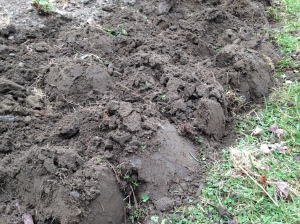
I wanted to transplant Lady’s mantle and forget-me-nots into the newly dug area. I plunked the little clumps down on top of the sod scoops, patted some dirt around them, and watered well.
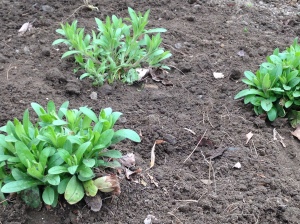
Then I added a stepping stone to make watering easier and covered the whole area with chopped leaf mulch.
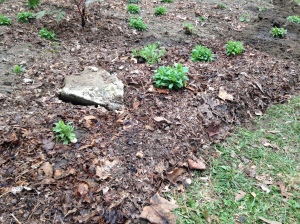
A week later I checked, and the sod was already breaking down. Earthworms everywhere and no weeds making their way up through the mulch yet. When they do, they’ll be easy to pull from the rich, crumbly soil.
Lazy feels good!